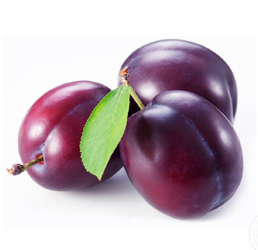Plum
Reliable culture draining starts in IV-VI centuries. BC during those times was grown extensively drain the noble in Egypt and was used by the population not only fresh, but also in the form of a variety of homemade.
Plum is prevalent in almost all countries of temperate climate. World production of plum fruit is approximately 3 million. tons. In the middle lane of trees grow in amateur gardens. The most serious obstacle to the expansion of crops of plums is the lack of hardiness varieties.
Chemical composition of plum fruit is quite varied and depends on the type (for example, Damsons, prune, Plum, etc.), grade, degree of ripeness of the fruit, soil and plant nutrition, climatic conditions and weather conditions and a number of other reasons that have often a very serious impact on their chemical composition.
Organic acid drain mostly Malic and citric in small quantities is oxalic, succinic, quinic acid and traces of methyl ester salicylic acid. In the composition of the sugars glucose and sucrose contained approximately equal amounts of fructose-much less.
With the maturing of fruits the amount of sucrose increases, which is a characteristic feature for some varieties (e.g. vengerok). Vitamin c in prunes very little, that is, of course, cannot have serious nutritional values.
In the fruit contained phenolic compounds, predominantly Flavonols (quercetin, izokvercetrin, etc.), anthocyanins and lejkoantociany possessing capillary tonic and antisclerotic action.
Different varieties of plums contain 0.1 to 2.7 mg/100 g of carotene (provitamin a). Carotene richer yellow fruits. In addition, prunes contain small amounts of b vitamins, niacin, folic acid.
Plum stand out among other fruits very high in vitamin e, it is significantly larger than the cherries, cherries, oranges, tangerines, pears, but lower than peaches and fruit trees. Of minerals there are potassium, iron, iodine, copper and zinc.
Plums are eaten fresh, cooked from her compotes, jam, jam, juices.
Therapeutic use of plums
* Fresh and dried plums (especially prunes), as well as preserves and juices with pulp have a gentle laxative effect, recommended for constipation and bowel atony.
* Prunes improves the condition of patients with atherosclerosis, because helps to eliminate cholesterol from the body.
* Plum is recommended at diseases of kidneys and hypertension.
* Potassium Compounds contained in fruits, have a diuretic effect, promote the excretion of excess water and salt.
* Plum leaves the home, in the fruit of the Blackthorn contains coumarins. These compounds have the ability to prevent the development of clots in blood vessels and cure thrombosis, as well as increase coronary vessels and provide a calming effect.
* Plum in folk medicine are considered useful for rheumatism and metabolic diseases (gout, etc.), and broths and lotions made from fresh and dried leaves are used as a wound-healing agent.
* In ancient medicine was considered useful plum adhesive (accumulate on the trunk). It was used in the treatment of ulcers, conjunctivitis, strengthening eyesight (locally).
ATTENTION!
Draining causes indigestion in young children, and in large quantities and in adults (because can be used as a laxative).
Plum also should not be used to nursing mothers (to avoid bloating and diarrhea in a child).


Leave a Comment